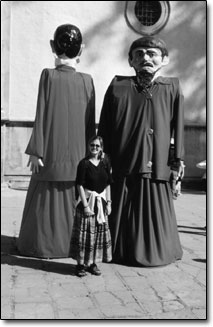W e decided to stop by Patzcuaro
at the last minute. My boyfriend and I were sitting in an
outdoor cafe in the university town of Morelia, enjoying our
daily dose of guacamole and flipping through our guidebook
for Mexico. The village of Patzcuaro was between us and the
coast. Why not stop by? The pictures of fishermen wielding
beautiful nets in the town's mountain lake looked cool.
But we didn't get to see the trademark fishing nets, because Patzcuaro was
in the throes of a celebration that happens only every 100
years.
Oblivious, we wandered through the streets of Patzcuaro looking
for a cheap hotel. We noticed that the bright banners and
the plaza full of musicians and vendors did  seem
festive, but Mexico itself is festive, so nothing seemed too
unusual. The hotel was sedate, the owner slow to answer our
ring for service. He mentioned something about the Virgin
of Health, but he was mumbling so we didn't really pay attention.
seem
festive, but Mexico itself is festive, so nothing seemed too
unusual. The hotel was sedate, the owner slow to answer our
ring for service. He mentioned something about the Virgin
of Health, but he was mumbling so we didn't really pay attention.
We emerged from the
squalid hotel back into the plaza and penetrated the crowds to
discover a massive "sand painting" project under way. People of all
ages were carefully using stencils to create bright art that
extended along the peripheral sidewalk of the main plaza. The
material they were using was actually not sand, but dyed sawdust
that formed a colorful chain of intricate flowers and brilliant
suns.
We watched the
meticulous precision of the artists until a noisy procession caught
our eye. Musicians and singers were pouring down a steep hill
toward us, while flanking a flatbed truck carrying a crucifix and a
bloody Christ. When the procession had finished its
circumnavigation of the plaza, we headed up the hill from where it
had come.
To our astonishment, we
found a full-scale town picnic under way, with every family eating
identical boxed lunches. We bypassed the long lines for the free
food, though not without employees of the sponsors calling after us
in English, "Drink Pepsi!" and giggling.
We wandered over to the
aging church, La Basilica de Nuestra Se`F1ora de la Salud, which
was adorned with powder blue and white streamers branching out from
its roof. Inside, another brass band was playing as hordes of
worshippers bowed to a small figurine about a foot high, perched in
a glass case above the altar. This was Maria herself, La Virgen de
la Salud. She was made from a corncob and honey paste by 16th
century Tarascan Indians and was still revered on January 20, 2000,
the day of her centennial celebration.
At another plaza, which
commemorated the death of a female revolutionary by firing squad, a
band was blowing itself red in the face as children played with
plastic airplanes and helium balloons. Strange "marionettes" twice
as tall as humans danced into sight with the string band that
followed them. One figure, half the height of the others, was
manned by a small boy who paused briefly to stare at the gringos
staring at him.
By this time we'd
started to catch on that this was a special day, so we fueled up
with a good dinner (graced, of course, by guacamole and Negra
Modelos) and reemerged to find night had crowded the plaza with
thousands of townspeople. We joined the expectant mob and I struck
up a conversation with the young woman next to me. What were we
waiting for? The appearance of the Virgin of Health. I asked if
this event was celebrated every year, and she snorted at my
ignorance, protesting, "No, no! Cada cien a`F1os" every 100 years.
What timing! When the Virgin finally arrived, led by a procession
of clergymen, I couldn't help joining in the vehement chorus of
"Maria! Maria! Rah Rah Rah!"
Fists in the air, the
locals continued their cheers as the Virgin was transported over
the lovely sidewalk paintings. Like Navajo sand paintings, this art
was created to be destroyed, as a testament of devotion. Elaborate
strands of fireworks exploded alongside Maria as she slowly
traversed the plaza. When she headed back up the hill toward her
church, local boys set off fireworks that shot like missiles
towards the sky, and Bryan and I noticed the moon wasn't full, as
it had been the night before. The celebration was coinciding with a
full lunar eclipse!
We joined the town as it
headed up the hill after Maria. The celebration peaked as we all
watched the tiny Madonna returned to her glass case, not to be
touched again for another 100 years.
There was more music and
cheering and fireworks as the celebration wound down. Women near
the church doors ladled out free cups of scalding fruit cider to
warm the families on their walk home. We cautiously sipped at the
liquid and watched the moon disappear. Local people resented
questions about the festival being connected to the eclipse; the
day was all about Maria, and the moon should not detract from her.
But while adults ignored the moon, the children holding their hands
couldn't walk straight they couldn't help staring up at the
phenomenon overhead.
This crazy experience
cemented my love for Mexico. Since then, Cinco de Mayo has become
more than an excuse to drink Mexican beer and tequila on May 5.
It's a day to remember how much Mexico kicks ass.
Jen Reeder

